This post may contain affiliate links. Please read our disclosure policy.

If you are looking for a waste-free recipe, I’ve got you covered with this 2-in-1 fresh homemade soy milk + okara tempeh!
Lately, I have been making my own soy milk because 1) It tastes better, and 2) It is much more natural than store-bought. The thing is, after straining the milk, you are left with a lot of soybean pulp, called okara. While this pulp can be used in baking, I wanted to use it in savory ways. Introducing okara tempeh!
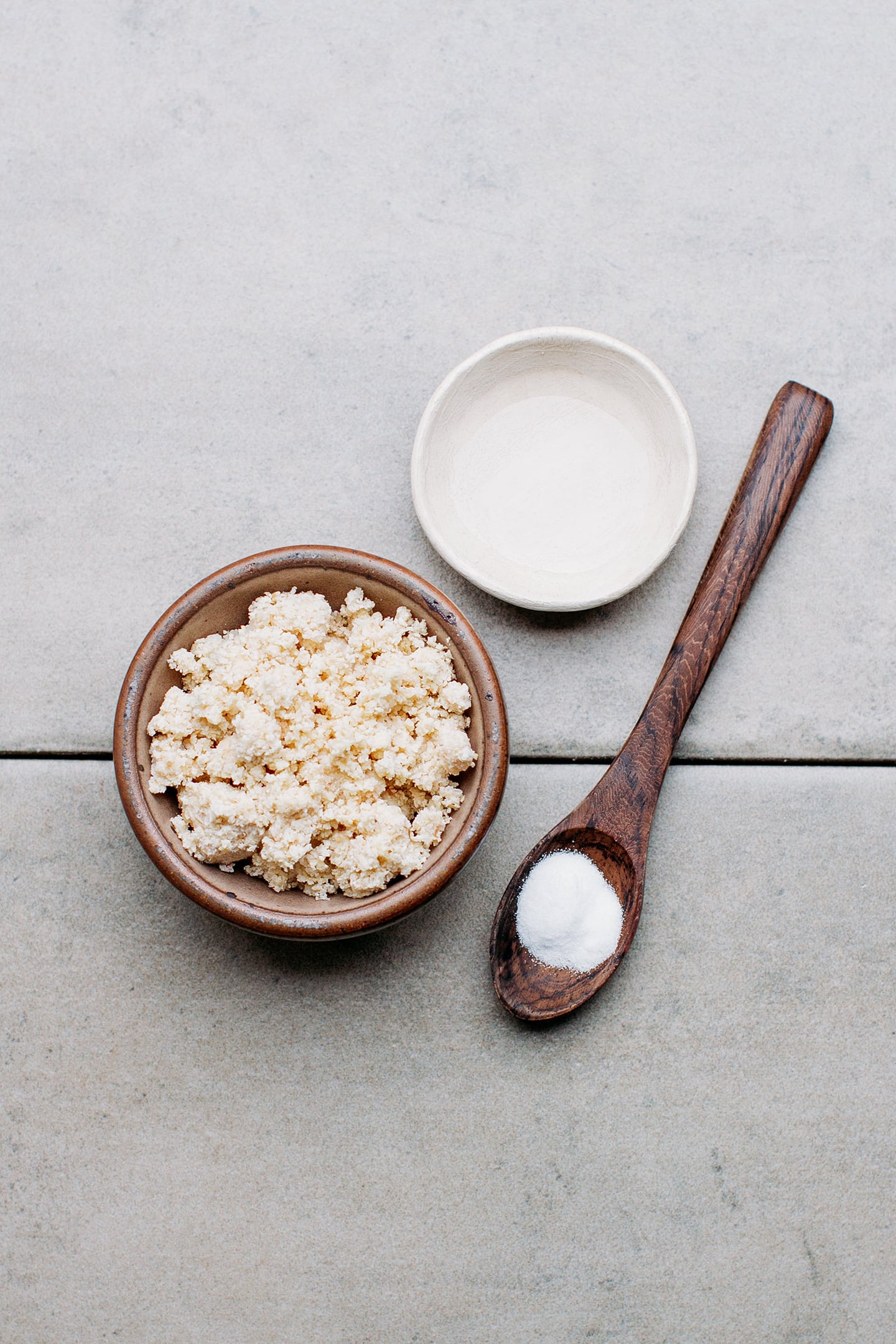
HOW TO MAKE SOY MILK
The method to make soy milk differs a bit from the one used to make nut milks. First, you want to soak the beans overnight, or for at least 8 hours. This will soften the beans, and make them more digestible. Once this is done, drain the beans and blend them raw with fresh water. At this point, for a creamier consistency, and a delicate nutty flavor, I added about 2 tbsp or roasted peanuts and 1 tbsp of toasted sesame seeds when blending the soy beans. It adds more fat, giving the milk a richer texture.
Next, pour the mixture into a large and deep saucepan and let it simmer for 10-15 minutes. During the first few minutes, a lot of foam will form, remove all of it with a large spoon or a laddle. Optional: For a subtle vanilla-like flavor, add 2-3 pandan leaves to the soy milk mixture while boiling, it will add a nice aroma to the milk.

When it comes to straining, there are two schools. Some prefer to strain the pulp before cooking, and others after. Here, we are using the Japanese version, that calls for straining the milk after cooking. Since we will be using the pulp (okara) to make tempeh, I prefer to cook the pulp. I also believe it adds extra creaminess to the milk, allowing the pulp to release natural fats.
Once the soy mixture has cooled down, use a nut milk bag to strain the pulp. Sweeten to taste, and your soy milk is now ready!
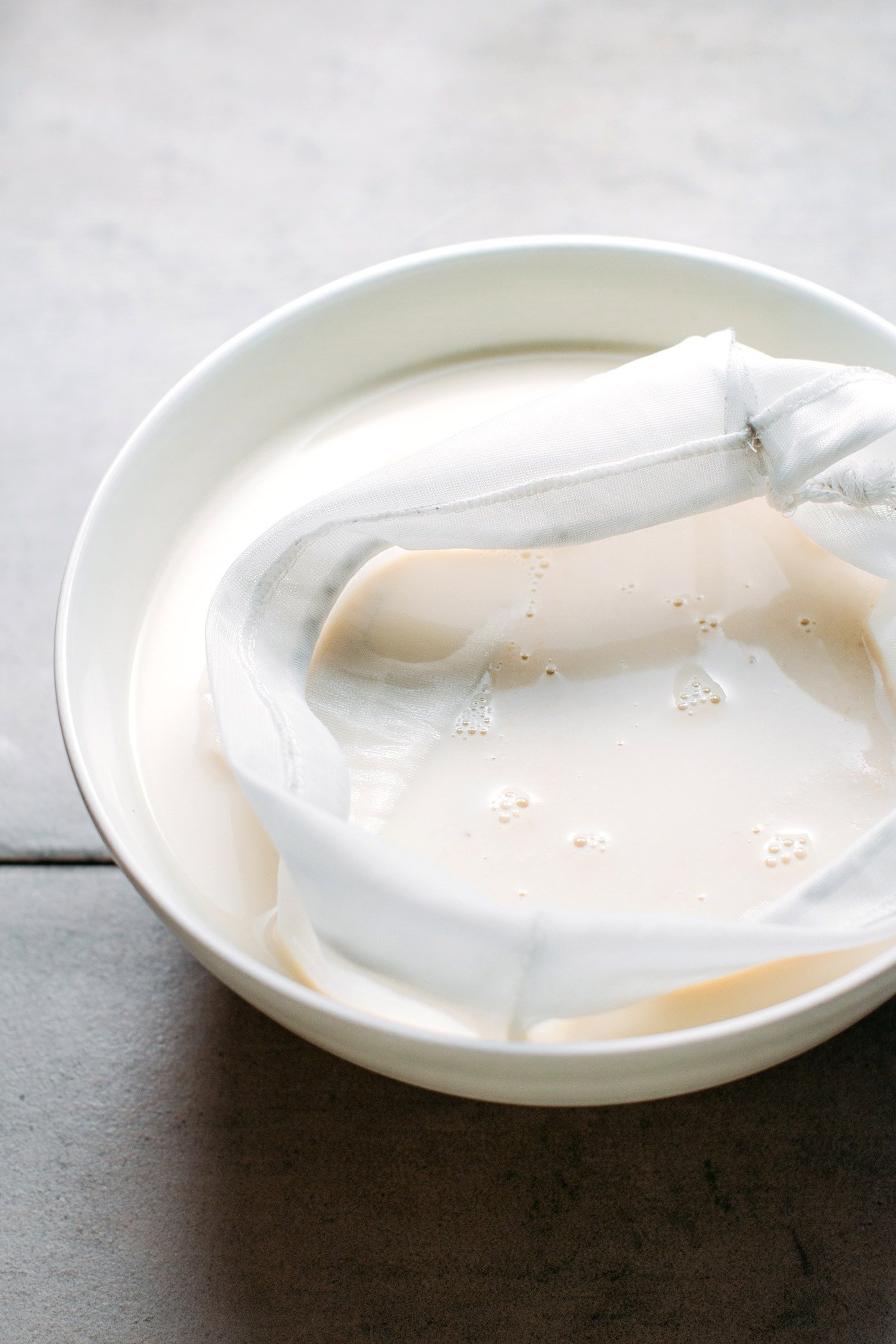
Fresh soy milk is SO GOOD! It’s delicious on its own, warm or cold. If you have never tried homemade soy milk, you will be surprised by its pleasant bean-y flavor! Enjoy alone, or in oatmeal, desserts, beverages, etc!
SOY MILK BENEFITS
Despite the bad reputation soy got lately, when soy milk is made from non-GMO, organic soy beans, it has many health benefits:
- High in protein: With over 8g of protein per cup, it is one of the richest plant-based milk.
- Contains vitamin B and omega-3 fats, reducing the risks of psychological diseases.
- According to studies, it is also said to lower cholesterol levels, prevent heart diseases and diabetes, and help with recovery after workouts.

HOW TO MAKE OKARA TEMPEH
Time to talk about the tempeh! If you are wondering if you should make this recipe mainly for the tempeh, I would definitely say yes! Okara tempeh is one of the best tempeh I ever had, it has no bitterness, a smooth texture, and a very delicate mushroom-y flavor. Plus, okara tempeh is high in protein, and makes a great base for plant-based burgers, bolognese, or vegan meatballs. It can also be marinated and pan-fried.
Once your soy milk has been strained, you want to spread the leftover pulp on a baking sheet lined with a clean kitchen towel to let the pulp dry. Let it dry for about one hour at room temperature.
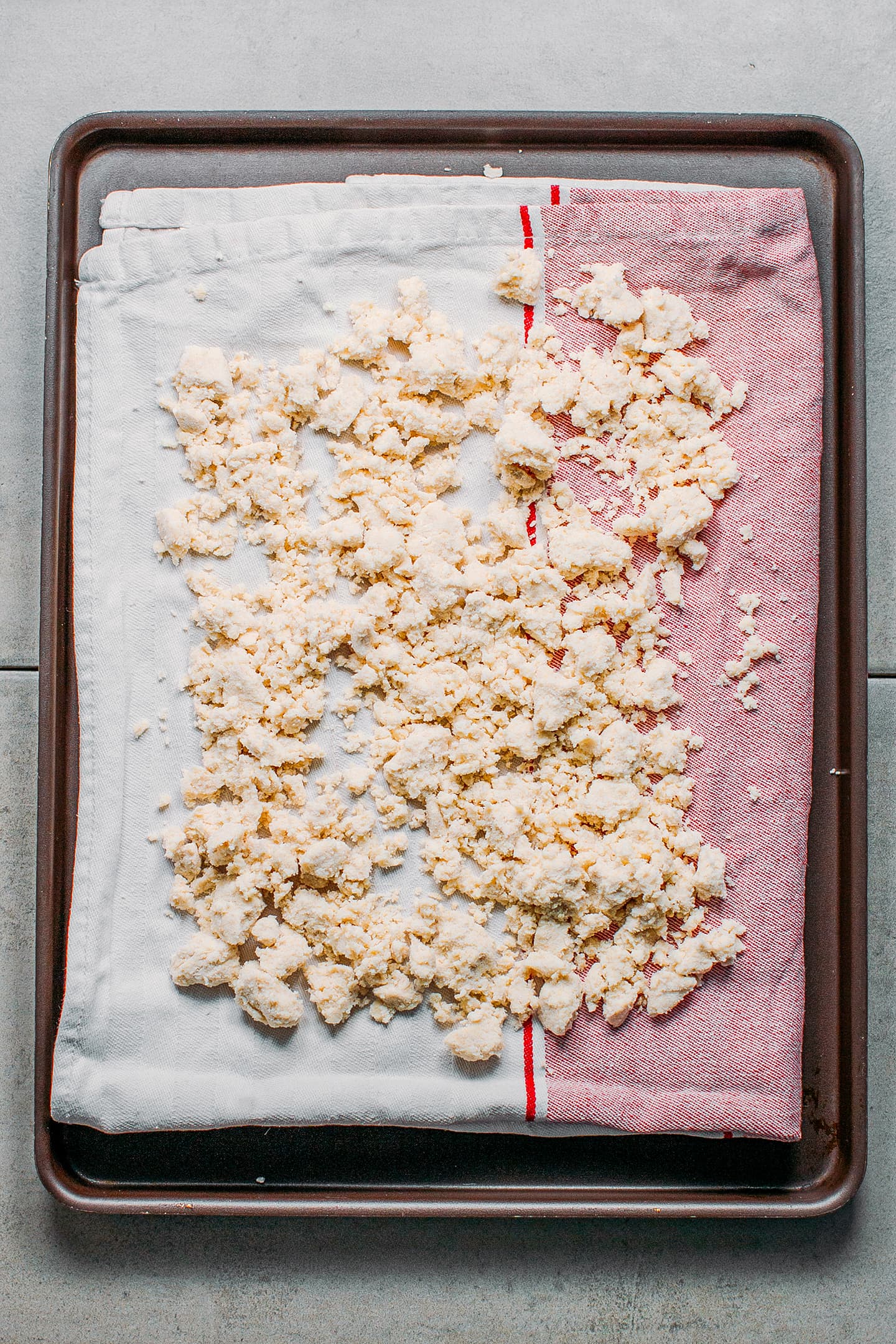
Once done, transfer to a mixing bowl, and add the white vinegar. Stir well before finally stirring in the tempeh starter. You can get your tempeh starter here or here.
Prick a freezer bag with a fork to make holes, this will let the tempeh “breathe”, allowing the mold to grow better. Add the okara to the freezer bag and pack it tightly into a loaf.

To incubate, I used the Instant Pot on Yogurt mode, which works perfectly every time! After about 20 hours, if you look closely you should see some white mold starting to form, that’s a good sign! Leave it for another 15 to 20 hours in the Instant Pot with the lid closed, the mold will keep growing.
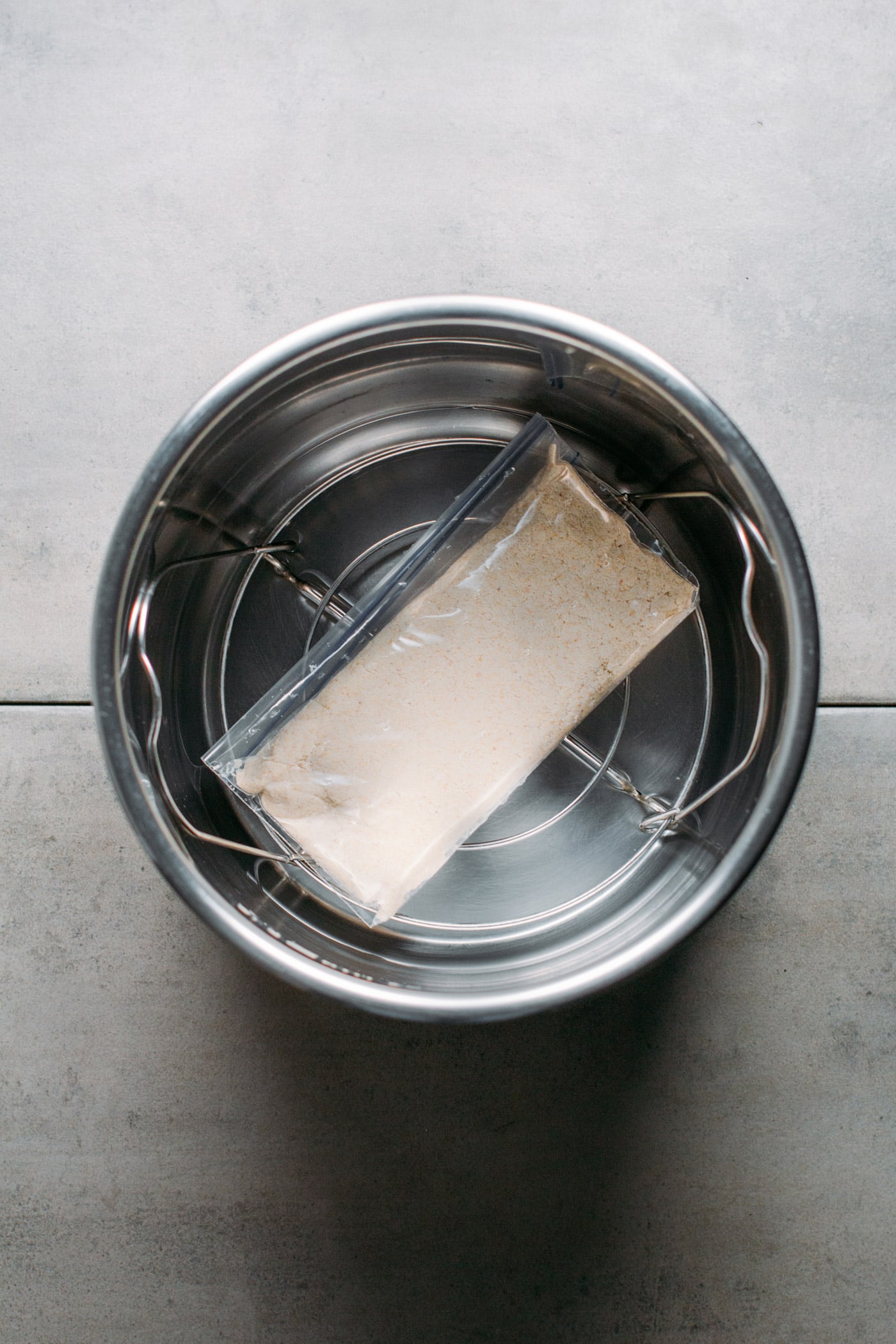
Quick note: I highly recommend letting your tempeh incubate until it is 90% covered with white mold, otherwise your tempeh will not hold together well and might crumble. Don’t be impatient! If incubated for at least 48 hours, your tempeh should be perfectly sliceable and will not crumble, even less than regular tempeh!
I usually leave the tempeh loaf in the Instant Pot for 20 hours with yogurt mode ON, then another 15-20 hours with the IP turned off. And finally, I transfer the tempeh to a warm room, or next to a radiator until firm, usually another 10 hours.
And after a couple of days, you end up with a delicious and smooth tempeh!
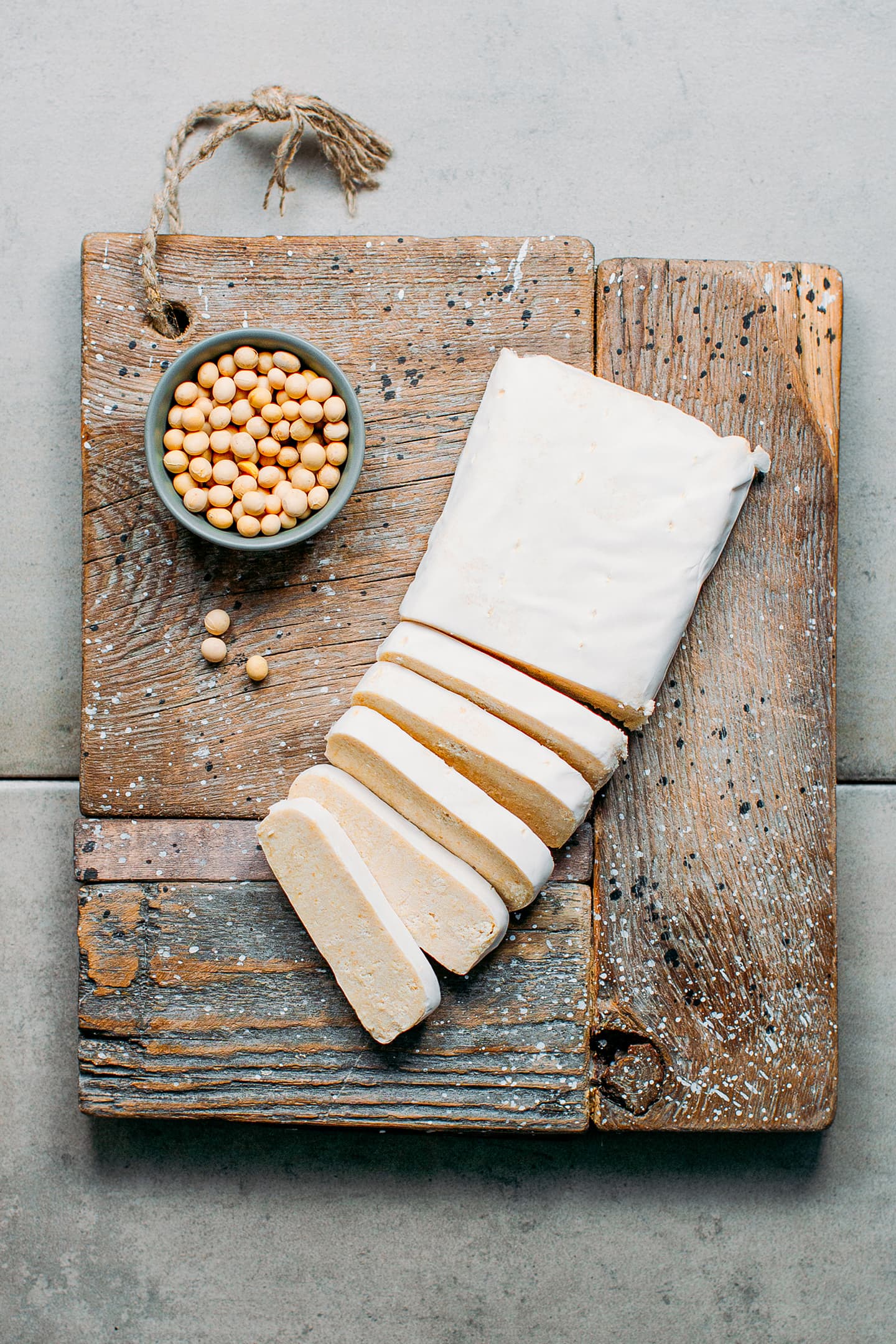
OKARA TEMPEH USES
You can use okara tempeh the same way you would use regular tempeh.
Here are a few ideas on how to use okara tempeh:
- Burgers: Tempeh makes a good base for homemade burger patties.
- Sautéed: Cut into thick slices or cubes and marinate. Then, pan-fry for a few minutes on each side. Add the leftover marinade and cook for another few minutes to coat the tempeh with the sauce.
- Use in Bao buns, like these Saté Bao with Kale Pesto, in place of the tofu.
- Crumble and use in plant-based bolognese sauce.
- Add to curries, soups, or stir-fries for extra protein.

I hope you will love this 2-in-1 recipe! The soy milk is so creamy with a delicious nutty flavor, and the tempeh is smooth with a very delicate flavor and no bitterness!
Looking for more tempeh recipes? Check out this Instant Pot Tempeh, Chickpea Tempeh, or this Back Bean Tempeh!
Le me know in the comments if you try this recipe!

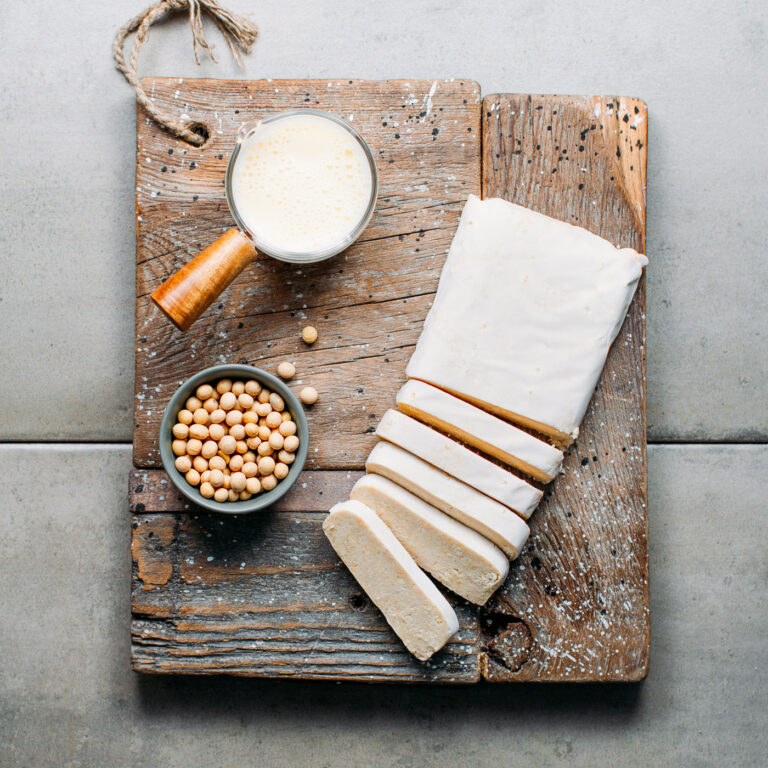
Okara Tempeh
Ingredients
Soy Milk
- 1 cup dried organic soybeans soaked overnight, or for at least 8 hours
- 2 tbsp roasted peanuts
- 1 tbsp toasted sesame seeds
- 1/8 tsp salt
- 6 cups water divided
- 2 pandan leaves (optional)
- 1 tbsp sugar (optional)
Okara Tempeh
- leftover soybean pulp from the soy milk
- 1 tsp white vinegar
- 3/4 tsp tempeh starter
Instructions
Soy Milk
- Drain the soaked soy beans and rinse under cold water. Add them to a high-speed blender. Add the roasted peanuts, toasted sesame seeds, salt, and 3 cups of the water. Blend on high for about 30 seconds.
- Transfer the soy mixture to a large and deep saucepan. Add the remaining 3 cups of water.
- Bring to a simmer over medium heat. Using a ladle or a tablespoon, remove all the foam that will form. There will be a lot of foam at the beginning, it's normal. Make sure to stir the mixture regularly to prevent the soy pulp from sticking to the bottom of the pot. After a few minutes, no more foam should form. Let the milk simmer for about 10 minutes, stirring regularly.
- Remove from heat and let it cool for about one hour, or until just warm. Using a nut milk bag, strain the soy milk over a large bowl. Squeeze the milk bag well to get all of the milk out. Add the optional tablespoon of sugar and stir to dissolve. At this point, you can let the milk simmer for another 10 minutes with 2 pandan leaves if you want to add a subtle vanilla flavor.
- Enjoy soy milk warm or cold! You can use it in beverages, oatmeal, baking, cooking, etc. Soy milk will keep for up to 4 days in the refrigerator.
Okara Tempeh
- Line a baking sheet with a clean kitchen towel. Spread out the the soybean pulp over the kitchen towel and let it dry for about 1 hour at room temperature.
- Next, transfer the soybean pulp to a mixing bowl. Add the white vinegar and stir using a wooden spoon to combine. Sprinkle the tempeh starter and stir again.
- Prick a small freezer bag with a thin fork (or toothpick) 8-10 times to create small holes in the plastic bag. Add the soybean mixture to the freezer bag and pack it tightly into a loaf of about 1-inch thickness. I usually just fill half of the bag and fold it in half.
- Add about 1 cup of water to the Instant Pot liner. Place the loaf on top of the steam rack, making sure it doesn't touch the water. Close the Instant Pot with the lid.
- Set on yogurt mode "Less" for 20 hours. After 20 hours, you should see some while mold. Use a paper kitchen towel to remove the excess condensation on the lid and on the bag. Close the Instant Pot with the lid again and leave it inside for another 15-20 hours. If your kitchen is cold, turn the Instant Pot on yogurt mode again.
- Check again after that, the mold should have grown even more. At this point, if the loaf is firm and fully white, you can remove it from the plastic bag and use immediately, or keep in the refrigerator for up to 7 days. If your loaf is not fully covered with white mold, place it in a warm room or next to a heat source for another 10-15 hours, the mold will keep growing.
- Use the tempeh in curries, burgers, stir-fries, etc!
Notes
Nutrition

About the Author
Thomas Pagot is the founder, photographer, and recipe developer behind Full of Plants. He created the blog in 2016 as a personal cookbook for vegan recipes. Through years of recipe development, Thomas has successfully grown Full of Plants into a trusted resource for plant-based recipes.

🧀 25 Mind-Blowing Vegan Cheese Recipes!
Sign up for the Full of Plants newsletter and you’ll get new recipes delivered by email weekly, PLUS your FREE 100-page printable eBook!


Great idea! But Unfortunately I do not have an Instant Pot Can I make my tempeh in some other ways?
You can use a dehydrator, yogurt maker, or place your tempeh near a heat source. It should incubate between 85-90°F.
For my regular tempeh, I’m using the proofer that I got for my sourdough bread. My Cosori dehydrator doesn’t go low enough in temperature and would kill the tempeh spores. Your okara tempeh definitely sounds interesting. I just saw the addition of the peanuts too late, but will try that next time. I assume I can just use the okara as is with the vinegar & tempeh starter and it should work? I wondered whether to try this and I ran across your site. 🙂 Awesome!
Yes, it should work without peanuts!
Thanks for your kind words Sabine 🙂
I have made my own soy milk for years. I only use organic soy beans to make it. I was wondering, do you think the okara from my recipe would work in making the tempeh? I tend to get tons of okara, so much that I can’t use it all. I’d love to find more uses for it.
If you cook the pulp with the milk, then your okara should definitely work!
Making soy milk is that easy??
Kim
It is! 🙂
Thanks ! Good ideas on enhancing the soy milk ! and to strain after cooking. Next I can try the okara.
What do you do if you don’t have an InstantPot? Some of us just don’t have room for more kitchen equipment!
You can use a dehydrator, yogurt maker, or place your tempeh near a heat source. Even an oven with the light turned on can work. The temperature should be between 85 and 90°F.
what do you do if you don’t have an InstantPot?
Can you freeze the soy milk without it curdling? Also can you freeze the okara until you want to make tempeh? I have beans and need milk but I don’t have tempeh starter yet. Thanks for a great recipe!
I haven’t tried freezing the soy milk or the okara, sorry.
Thank you! After tasting this sort of tempeh in Bali I was very curious how to make it as I love fermented foods. When I tried mine didn’t work out, probably something went wrong with humidity levels or temperature. Can’t forget those delicious and fragrant stews and sautees, I will try the way you are recommending here 🙂
I had no idea they were making okara tempeh there!
Hi, Bali is part of tempehland of Indonesia. We are kind of no waste people.
You could also simply bread it with flour, garlic powder, onion powder, green onion & chili slices + water, then fry. It’s usually the way the Indonesians cook it.
Thanks for sharing Ima!
Deep-fried tempeh sounds delicious!
I live in the tropics (Australia) where the daily maximum temperature is around 30C. I make my tempeh by incubating on the bench top! No need for a heat source! I can only make it like this in summer of course. I also freeze the cooked beans ( or Okara) with the inoculate. Then when I want tempeh I simply take it out of the freezer, perforate the freezer bag, and onto the bench.
Interesting, thanks for sharing Beryl!
Bonsoir Thomas
J’ai bien envie d’essayer de faire ta recette.
Si tu as le temps, peux-tu me confirmer que le poids de soja est 200 grammes et le volume d’eau 1416 millilitres ?
Je ne suis pas certaine de comprendre les mesures.
Merci pour ta réponse.
A bientôt.
Bonsoir Karine,
Tu peux changer les mesures en “metric” depuis la recette. Le soja est donc de 180g et 1.4L d’eau.
I didn’t like the taste of the milk at first, it was better after simmering the second time. I decided to make yogurt out of it and it was very good! The tempeh worked as well! Love the no waste aspect. thank you!!!!
That’s the taste of real soy milk that hasn’t been processed 🙂 If you are used to commercial soy milk, the flavor is quite different I agree, they use several processes to remove the natural “beany” flavor.
Glad to hear you liked the tempeh!
I’m unclear about one thing. If you want to add sugar or the pandan leaves, are you supposed to drain in through the nut bag and then return it to the pot for a second boil? Or add them after 10 minutes, simmer again for 10 minutes and then strain?
So regarding the sugar, you simply dissolve it into the milk after straining.
For the pandan leaves, I usually boil them with the milk and pulp.
Bonsoir Thomas,
Je te remercie beaucoup d’avoir pris le temps de me répondre rapidement au sujet des poids et volume pour faire le lait de soja.
J’ai mis le soja à tremper pour la nuit.
Après, je fais ta recette de tempeh.
A bientôt.
Hi , thank you for lovely recipe but I do not have instant pot so what to ?
Hi Huda,
I replied to a similar question. So, you can use a dehydrator, yogurt maker, or place your tempeh near a heat source. It should incubate between 85-90°F. During the summer, just leaving it at room temperature works pretty well.
Bonjour Thomas,
Ci-joint un lien qui a beaucoup servi pour les premiers essais de tempeh en bricolant un incubateur isotherme :
https://pigut.com/2010/10/14/tempeh-maison/
Si ça peut aider 🙂
Merci pour toutes tes recettes et tes belles photos.
A bientôt.
Bonjour Karine,
Merci ! Effectivement, si ça peut aider certains 🙂
I have been meaning to try making this for ages, but haven’t been able to find soybeans locally lately. It seems like it would make a great replacement for tuna in a tempeh tuna salad. Or a base for vegan gefilte fish!
Hi Thomas, do you know the approximate quantity of okara this results in? I have a bunch in the freezer that I can thaw out to make the tempe, if I know how much I need! Thanks.
Hi Beth, I haven’t measured the amount of okara after making the soy milk. I would say about 1 cup, maybe one and a half.
Hi Thomas
Can you use whole soya beans in this recipe without splitting/dehulling?
Thanks!
Hi Rachael,
Yes! That’s what I used, and I didn’t bother dehulling 🙂
Thanks so much Thomas! I’m currently making a batch in the Instantpot (I dehulled that batch just in case but really happy it isn’t necessary) and it’s looking amazing! The homemade soya milk is delicious too! Very happy! Thanks so much for all your wonderful recipes!
Great! Glad you like it 🙂
What process was used to estimate the calories/nutritional profile for the Okara Tempeh?
I took a look at different brands of commercial okara and made an average of the nutritional information.
First attempt was not a success 🙁 but I will try again! not sure what I did wrong but it could have been lots of things. I bought this starter https://shop.culturesforhealth.com/products/tempeh-starter and was confused how much to use, because they recommend a whole packet which is way more than 3/4 tsp. they also recommend 2 tbsps of vinegar rather than 1 tsp which is quite different. I wasn’t sure if my starter was diluted or what so I ended up splitting the difference and doing half a pack of the starter and like 1 tbsp vinegar. I put it in the oven with the light on and after a few days I had some white streaks but not the whole thing. I moved it closer to the oven light thinking it wasn’t hot enough. 4 days later the brick is still not fully white and I’ve decided to chuck it due to smell 🙁 It could have been the wrong ratio, not enough heat, too much heat, not enough ventilation…not sure
Hi Kerrin,
I would recommend following the recipe, not what’s written of the package 🙂 I buy mine from here, and the ingredients seem the same as the one you bought.
Can I use apple cider vinegar instead of white vinegar?
That should work!
Soy milk turned out great! My tempeh never cultured so I bought an instant pot to try it once more. I’m about 36 hours into the process and I’m wondering what smell is normal for it? It’s not smelling fantastic but no discolored mold has showed up so it seems ok?
Great! Be patient with the tempeh, it can take up to 3 days to be fully ready. The smell reminds me of camembert, a bit mushroomy.
Thanks for sharing. I make soy milk regularly and am trying to use okara to make tempeh for the first time. Hope to succeed with your tips.
I also use okara in bread making, spicy burgers etc.
Surinder Kaul
Hi! I was wondering if it’s possible to make tempeh without the starter? Like you can do vinegar witouth the mother? It’s just that I live in Benin, Africa, so it’s almost impossible to find the starter here.
Also, do you have a recipe for making tofu?
Thank you 🙂
Melissa
Hi Melissa,
I really doubt you can make tempeh without any starter. It’s probably possible to create the mold (Rhizopus oligosporus) but I am not familiar with the process, sorry.
I don’t have any recipe for making tofu yet!
Hi, Thomas,
Great again! I have some okara flour I have occasionally used in baking. Can I use that to make tempeh, or maybe mix the okara flour with the homemade okara to make tempeh?
Hi Jan,
I have never used okara flour so I’m not really sure. I would guess okara flour is much dryer than fresh one, so it might not work as well.
I love this idea! Horses also like eating it.
Glad you like it!
Is this the type of tempeh that would be close to what is sold in health food stores as “imitation chicken” or other meats?
I’m afraid I have never seen tempeh sold as imitation chicken, what is the texture of this type of tempeh?
I really like the texture of Okara tempeh, it’s easier to handle compared to regular soy tempeh. Will be making this often, thank you!
Thanks for your feedback Yusra!
Your recipe looks really good. I want to do it. I never tasted tempeh, but I very tempted by your recipe, I have a lot of okara from making soy milk and tofu. But you said you cook the milk with the okara, it does not work well for me… is it ok if I cook the okara 3 minutes in the microwave and then do the tempeh? And I don’t add any sugar in my soy milk because I cook with it, will it change the taste or interfere in the process of making tempeh? Thank you so much.
Yes, cooking it in the microwave for a few minutes should do it.
There is no need for sugar to make tempeh, so you should be good!